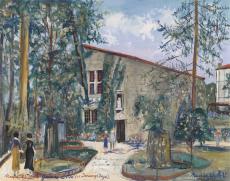


Φαίνεται πως ο Maurice Utrillo ζωγράφισε το σπίτι της Ιωάννας της Λωρραίνης για πρώτη φορά το 1930·1 στη συνέχεια, ξαναδούλεψε πολλές φορές αυτό το θέμα με λάδι ή ακουαρέλα, οι τελευταίες εκδοχές του οποίου χρονολογούνται το 1947.2 Ο βαθιά θρησκευόμενος ζωγράφος ήταν ιδιαίτερα προσηλωμένος στη μορφή της Ιωάννας της Λωρραίνης (1412-1431), της καθολικής αγίας και προστάτιδας της Γαλλίας που αγιοποιήθηκε το 1920. Από τους πλέον σημαντικούς και εμβληματικούς θρύλους της Γαλλίας η ιστορία της νεαρής χωρικής, που έγινε πολεμιστής και πολέμησε για τον βασιλιά της Γαλλίας, έως ότου παραδόθηκε στην πυρά. Το σπίτι που γεννήθηκε υπέστη τροποποιήσεις στην πρόσοψή του μετά τον θάνατό της και ανακηρύχθηκε ιστορικό μνημείο το 1840. Σε αυτήν τη δροσερή και ζωηρή υδατογραφία, ο Utrillo αποτύπωσε το σπίτι της αγίας λεπτομερέστατα, χωρίς να παραλείψει να δηλώσει μέσα από σχηματοποιημένες μορφές την παρουσία επισκεπτών που, από πίστη ή και από απλή περιέργεια, εξακολουθούν και σήμερα να συρρέουν σε αυτήν την κατεξοχήν συμβολική τοποθεσία. Ο Utrillo χρονολόγησε το έργο στο 1935 και το αφιέρωσε στον επίσκοπο Mégnin. Η ένδειξη αυτής της προσφοράς στον ιερέα μάς υπενθυμίζει ότι ο Jean-Baptiste Mégnin (1883-1965), επίσκοπος της Angoulême από το 1934 έως το 1965, τέλεσε τον θρησκευτικό γάμο μεταξύ του Utrillo και της ηθοποιού Lucie Valore στην Angoulême στις 3 Απριλίου 1935.
Γεννήθηκε στη Μονμάρτρη και ήταν γιος της ζωγράφου Suzanne Valadon, η οποία είχε ποζάρει ως μοντέλο για τον Edgar Degas και τον Pierre-Auguste Renoir. Η μητέρα του, ζωγράφος και η ίδια, τον ενθάρρυνε να ασχοληθεί με τη ζωγραφική για να βρει διέξοδο από τις ψυχικές διαταραχές αλλά και τον αλκοολισμό του. Ο καλλιτέχνης ανέπτυξε ένα ιδιαίτερο ύφος, απεικονίζοντας με προσεγμένες πινελιές και με περισσή λεπτομέρεια μάλλον μελαγχολικές απόψεις εκκλησιών, εργοστασίων, στρατοπέδων και άδειων δρόμων, τις οποίες ζωγράφιζε εκ του φυσικού, από καρτ ποστάλ ή από μνήμης. Ήδη το 1910 το έργο του είχε αναγνωριστεί, ενώ από το 1920 καθιερώθηκε διεθνώς.